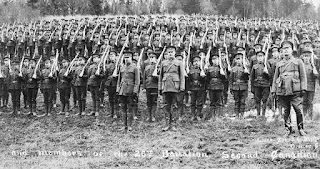So, how did we get there?
When the war began we were very much a British colony. With our large-and-in-charge father Britain and sassy mother France going to fight it out with Germany and Co. over in Europe, it was our duty to step in and provide whatever support we could. However, since we were still a self-governing body, it was up to us to decide just how many men we were going to send their way. We certainly wished to help Britain, but at the same time didn't want to cripple our fledgling population and economy - plus, who knew how many would show up to answer the call? Canada, after all, had a population that was 65% rural and many thought that the war had more of a "big city" feel to it, and continuing the work on the farm was of greater importance. Also, who would think of World War I and think "yeah, I'm in"? Well, as it turns out, a heck of a lot.
 |
| A picture of Valcartier, the largest military base in Canada at the time. It's probably bigger than it looks here. This angle puts it slightly above "hobo shanty town." |
As for the types of men that were chosen, Sam Hughes, the Minister of Militia and Defense, decided to shirk recruitment recommendations and build the military with a mostly civilian force. Sending the 30,617 chosen to a newly created military base called Valcartier, it was about as ragtag as a group could be; they showed up in suits, bowler hats, uniforms of their local militia, and many of them had to begin training in such, as uniforms were not as of yet distributed. It didn't help that Hughes himself was a bit on the crazy side, frequently interrupting training, demoting people at random, and shrugging off the need to have experienced soldiers take the lead on instruction to create a cohesive force. By military standards Valcartier was a mess; the men were insubordinate, more brawlers than soldiers, and typical military stuff (saluting, spotless boots, doing pushups while being called a "maggot" and so forth) was mostly dismissed as nonsense. Practical jokes were common and typically if there was a major problem it would be settled by a fistfight.
 |
| The brave men leaving Toronto for battle in Western Europe. I mean, I know Toronto is expensive, but this?! Hiyo!!!! |
Nevertheless, in spite of everything, the Canadian forces set sail with the men, artillery, and seven thousand horses, carried across the waters by ocean liner. Arriving at Salisbury Plain, a military camp quite near to Stonehenge, they were given a week before more training would continue. During this time they drank: a private described the unruly force as thinking "of nothing but drinking and getting into all the trouble they can." Some of that trouble came in the form of loose women; 1,249 (keep in mind only 30,617 came over) picked up a venereal disease during that time. Eventually they allowed booze in the camp, mostly to slow the tide of rampaging Canadians causing a ruckus across Britain.
 |
| One of the Canadian battalions. Or perhaps a division. No, a unit! That's not right... Anyways, here's a group of Canadian soldiers. |
As for the conditions in the camp, well... the training was effective but the weather was brutal. Pounding sheets of rain hammered the men day after day, making training a muddy, sick, unpleasant experience. However, the awful conditions helped to toughen them up, and the difficulties served as a bonding time for the inexperienced force. It's beautifully summed up by this lieutenant and former war correspondent:
"On Salisbury Plain, chastened by suffering, saddened by yearnings for home, wounded to the quick by misunderstandings with our English instructors, torture by the vilest winter climate on earth, often prostrated by sickness of the body, or by deeper sickness of the spirit, out of all of this man-breaking and heart-breaking we were being hammered and wrought into an army unit. Out of hell fire, came an Iron Division for service in an Iron War."
It wasn't long before Canadians got their first test in battle. After the training was complete, they were sent to the western front to support British soldiers in trying to break the unbreakable; trench warfare had begun, and it was up to the Triple Entente's forces (the Russians, British and French) to break the line. Defenses wouldn't hold; the Germans had broken into France and had already stormed through Belgium, meaning a defensive position would be in Germany's favour.
After shadowing experienced British soldiers for some time, they got their first real taste. The initial deaths, through exploding artillery fire or snipers, shook the men to the core. They weren't mentally prepared, but to be fair, how could one be? Their first major battle to test their nerve came at Neuve Chappelle on March 10th, 1915. Basically, the Canadians were used as a diversion force to ensure the Germans couldn't mass a large number where the British, with their Indian allies, hoped to attack. They lost one hundred men, but did their duty.
In spite of the inferior rifles, sloppy training, frequent insubordination and liquor issues, the Canadian army would soon prove to be one heck of a formidable fighting force. Suffice to say, I bet no one saw that coming.
No comments:
Post a Comment